25.27.
Electronically Controlled Automatic Transmission
An automatic transmission selects the most appropriate gear ratio for the prevailing engine speed, power train load and vehicle speed conditions, without any intervention by the driver. All gear shifting is carried out by the transmission system itself, and the driver only selects the desired operating mode with the selector lever. The Society of Automotive Engineers (SAE) has recommended that the selector should have the sequence PRND321in the case of a four-speed transmission as follows.
P (Park). In this position the transmission is in neutral and the transmission output shaft is locked by means of a parking pawl. The engine can be started.
R (Reverse). In this mode a single-speed reverse gear is selected and held. Engine braking is effective in this position, but the engine does not start.
N (Neutral). This mode is the same as Park, but the output shaft is not locked. The engine can be started.
D (Drive). This is the normal gear selection for forward motion. The vehicle may be operated from a standstill upto its maximum speed, with automatic upshifts and downshifts. The gearshift is made by the gearbox depending upon its assessment of vehicle speed and engine load. When rapid acceleration is required for overtaking, the driver can push the throttle pedal to its full travel to attain a speedy downshift into a lower gear. The engine does not start in D-drive range.
3 (Tliird). Operation of this gear varies between manufacturers. In general the transmission operates in D range, but is prevented from up shifting into fourth gear.
2 (Second). Operation of this gear also varies between manufacturers, but normally the transmission can only operate in first and second gear. Two is usually selected to provide engine braking when driving in hilly country or when towing.
1 (First). The transmission is locked in first gear to provide powerful engine braking. This is used when driving on steep hills or when towing.
To prevent inadvertent starting of the vehicle in a gear, a gearbox ‘inhibitor switch’ (also called a ‘neutral switch’) is positioned in series with the starter motor solenoid supply. The inhibitor switch contacts are closed when the selector lever is in Park or Neutral and so the engine can be started only in these positions. For additional safety the selector lever is equipped with a mechanical interlock, which does not allow the lever to be moved out of Park for example unless a spring-loaded release button is pressed.
The use of a microcomputer control system provides precise control of the hydraulic system thereby enhances the performance of the automatic transmission, offering. (i) Crisp and smooth gear shifts with consistent quality.
(ii) Perfectly timed gear shifts.
(Hi) Elimination of hunting shifts.
(iv) Protection of the transmission by constant monitoring of engine and transmission speed, temperature and so on.
(v) Driver-selectable shift pattern options for extra performance or economy, or for icy road conditions.
(ui) A simplified hydraulic control system.
An additional advantage of electronic control system is that the microcomputer can store diagnostic trouble codes. This greatly assists the mechanics in the quick repair of faulty transmission units.
25.27.1.
Components and Parts of an Automatic Transmission
Figure 25.61 represents a sectional view of an electronically controlled automatic transmission used for front-wheel drive cars. Although transmission designs vary among manufacturers, the major components as described below are common to all.
Torque Converter.
The transmission bell housing is bolted to the rear of the engine block. This encloses the torque converter, which is secured to the engine flex-plate (a lightweight flywheel) by several small bolts. The torque converter is a virtually wear-free fluid coupling, which multiplies and transfers engine torque to the gear train through the input shaft.
Gear train.
The gear train is normally a compact compound epicyclic train capable of providing several different ratios. Commonly used gear trains include the Simpson, Ravigneaux and Wilson types. Variable-reluctance type sensors are installed in the transmission housing to monitor the input (turbine) and output shaft speeds.
Friction Elements.
Various hydraulically operated brake-bands, multi-plate clutches and multi-plate brakes are used to couple or lock the appropriate sets of planetary gear elements required for obtaining different gear ratios.
Oil Pump.
The hydraulic pressure required to operate the various friction elements (clutches and bands) is supplied by an oil pump, mounted just behind the torque converter, and driven by the engine through the torque converter housing. Oil pump output pressure (commonly known as line pressure) is regulated by an electronically controlled solenoid valve and directed to the appropriate clutches and bands by shift solenoids. The solenoid valve accurately modulates line pressure during gearshifts for smooth and rapid gear changes.
Electro-hydraulic Control Unit.
The electrohydraulic control unit, also known as the valve body, is generally positioned beneath the gear train and houses a number of mechanical and solenoid valves. These valves direct and modify the hydraulic fluid flow to the various clutches and brake-bands. The solenoid

Fig. 25.61. Electronically controlled automatic transmission for front-wheel drive vehicles.
valves execute gear change commands issued by the microcomputer in the transmission electronic control unit (transmission ECU). The transmission ECU thus controls the sequence and timing of gear ratio changes, and also the quality of the changes.
Transmission Housing.
The transmission housing is a lightweight aluminium casting and holds all of the transmission components as well as various sensors. It is usually designed for easy replacement of the valve and sensors with the transmission installed in the vehicle. At the base of the housing a sump pan is positioned and is kept filled with transmission oil, basically an SAE 20 grade mineral oil with various additives po improve its frictional and low-temperature properties. Various pressure taps are provided on the side of the housing to connect a pressure gauge during undertaking basic diagnostic tests.
Torque Converter Operation.
A torque converter transfers the crankshaft rotation to the automatic transmission. The converter absorbs the shocks of gear changing and dampens out vibrations, thereby permits the engine to smoothly drive the transmission from a standstill upto maximum speed. The torque converter has an external shape like a large metal donut, with a sealing weld around its outer edge. Internally, it has several elements mainly an impeller, a stator (sometimes called a reactor) and a turbine, as illustrated in Fig. 25.62.
The impeller is mounted to the torque converter shell and therefore is directly driven by the engine. The transmission pump is also driven by the engine, due to which with the engine running the torque converter is filled with transmission*fluid under pressure. As the impeller is rotated, centrifugal force throws fluid from the centre outwards so that fluid strikes the turbine blades causing the turbine to rotate, thereby turning the gearbox input shaft. Fluid leaving the turbine blades is then redirected by the specially curved stator blades back onto the impeller blades at such an angle that it helps the engine in driving the impeller (Fig. 25.63). It is this redirection of fluid energy that makes the torque converter to multiply engine torque by a factor upto two, providing good drive characteristics.
The torque converter “coupling point” occurs when the impeller, turbine and stator all revolve at about the same speed. The torque conversion ratio is 1:1, with a coupling efficiency of over 90%. During normal driving the torque conversion ratio continuously varies between about 2:1 and 1:1 depending upon the load on the engine.
Lockup Clutch Operation.
When a torque converter is operated in the coupling phase, a speed difference (slip) of upto 10% can exist between the impeller and the turbine. The slip causes a loss of fuel economy during high speed cruising, in addition to wasteful heating of the transmission oil. The torque converter lockup clutch was introduced in the 1970s in order to eliminate this slip.

Fig. 25.62. Torque converter construction.
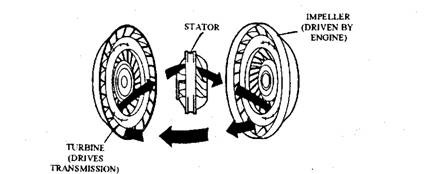
Fig. 25.63. Exploded diagram of torque converter showing fluid path.
The operation of the lockup mechanism is illustrated Fig. 25.64. The lockup clutch uses a narrow friction lining 20-30 mm wide, bonded to a thin metal disc (sometimes called a piston), which is attached to turbine through a torsional damper spring. The transmission ECU controls fluid flow into the torque converter chamber with the help of solenoid valves. To lock-up the torque converter, the transmission ECU directs fluid into the port “C”, and allows exit via ports “D” and “E”. The lockup piston thus engages against the converter cover and the torque converter is placed in direct drive.
In order to disengage the lockup clutch, the transmission ECU actuates the solenoid valves to direct fluid into port “E” and allow it to exit from ports “C” and “D”. This causes the clutch piston to move away from the impeller so that the converter is placed in hydraulic drive enabling torque-multiplication.
Damper (Lock-up) Torque Converter.
The damper (or controlled slip) torque converter was introduced by Mitsubishi in 1982 and has since been used by several manufactures as a means of solving inherent drawbacks of conventional lockup torque converters. Damper torque converters cause partial lockup at low

Fig. 25.64. Torque converter lock up clutch. A. Engaged position. B. Disengaged position.
speeds in low gears, which is not possible with conventional lockup converters due to engagement shock and engine vibration.
In the damper torque converter the lockup clutch engagement is more accurately controlled by the transmission ECU by constantly monitoring the slip in the converter (i.e. the difference of the impeller input speed and the turbine output speed). The measured slip is then compared to a set point value stored in the transmission ECU’s memory. The ECU depending on the result of this comparison operates the lockup clutch fluid-control solenoid valve in a duty cycle mode at a high frequency (about 30 Hz) to vary the fluid flow to the converter providing just the right clutch contact pressure for the required slip. In this way clutch slip is controlled in the range 1-10% of input rpm, causing a smooth and vibration free operation.
Provision of Gear Ratios.
In a conventional automatic transmission an epicyclic gear train provides gear ratios. Figure 25.65 shows a Simpson gear-train capable of providing three forward gear ratios and reverse. The selection of the appropriate ratio depends on the application of hydraulic pressure to clutches and brake-bands operating in a set pattern. The electro-hydraulic control valves regulate the engagement of friction element based on the signals received from the transmission ECU and direct line pressure accordingly.

Fig. 25.65. Simpson gear-train.
Low gear is obtained by engaging the forward clutch, so that engine power is applied to the ring-gear of the first gear-set, thus rotating the planet wheels clockwise to drive the common sun gear anticlockwise. The one-way sprag clutch prevents rotation of the planet carrier of the second gear-set and therefore the planet wheels rotate to drive the output shaft in compound reduction. Engine braking is accomplished by applying the low reverse brake band to disable the free wheeling effect of the sprag clutch.
To select intermediate gear, the intermediate brake-band is applied to lock the common sun gear against rotation. With the forward clutch engaged, power flows to the first ring-gear, thereby driving the planet wheels around the sun gear and rotating the output shaft in simple reduction drive.
To obtain high gear, both the forward and the reverse-high clutches are engaged, so that the sun gear locks to the first ring-gear. The whole gear-train revolves at the same speed as the input shaft giving direct drive.
Reverse gear is obtained by engaging the reverse-high clutch and the low-reverse brakeband so that drive is transmitted through the sub-gear to the planet wheels of the second gear-set, as a result the ring-gear turns in the opposite direction to the input shaft. The low reverse brake band holds the planet carrier of the second gear set against rotation, causing the output shaft to turn,
25.27.2.
Transmission Control System
The operation of a typical electronically controlled transmission system is illustrated on Fig. 25.66, which has been installed by a number of vehicle manufacturers, including Mazda, Nissan and Rover. The system offers four forward gears, controlled by a transmission ECU, which communicates with the engine ECU to provide total power train management. The transmission ECU takes decisions based on electrical signals received from various sensors located on the engine and gearbox. ECU’s microcomputer stores data relating to the ideal gear for every speed and load condition, along with correction factors for engine and transmission temperatures, brake pedal depression and so on. Using this corrected data the transmission ECU energizes solenoid valves to engage the most suitable gear ratio for the existing driving conditions. The transmission ECU also provides a self-diagnosis function on some of the sensors and operates a fail-safe mode if a fault is found. This electronically controlled automatic transmission offers some typical features as follows.
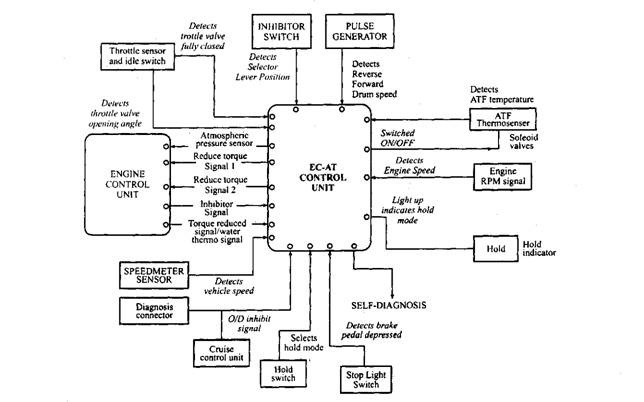
Fig. 25.66. Transmission control system structure (Mazda).
(i) It incorporates a duty-cycle solenoid valve to vary line pressure so that clutch and brake-band engagement force is optimized during each gearshift.
(«’) It controls the engine and transmission totally by reducing the engine torque during
gearshifts, thereby producing smooth gear change. (Hi) It contains a duty cycle lockup solenoid, which causes controlled-slip lockup at low speeds and provides less shock when engaging full lockup at cruising speeds.
(iv) It includes optional control programs, selected by the driver, allowing POWER or HOLD shift patterns to be engaged. The POWER program delays each upshift by a few hundred rpm to permit a sporty driving style. HOLD causes the transmission ECU to hold a selected gear, which is useful when driving in hilly country or on difficult road surfaces.
25.27.3.
The Transmission ECU Input System
The heart of the transmission control system is the transmission ECU, which accepts inputs from various sensors and communicates with the engine ECU.
The pulse generator is a magnetic pickup, located in the upper part of the transaxle casing and detects the gear-train’s reverse-forward drum speed, i.e. the torque converter output speed.
The speedometer sensor is a magnetic pickup sensor, which detects the gearbox’s output shaft speed, i.e. the vehicle speed.
The throttle sensor and idle switch is a combination sensor containing a potentiometer and also a pair of contacts, which close when the engine is at idle. It detects throttle angle and hence engine load. When idle is detected, and the vehicle is stationary, the transmission ECU engages second gear. This minimizes torque loads on the transaxle and reduces creep when stationary in traffic. First gear is engaged as soon as the ECU detects movement of the accelerator pedal.
The inhibitor switch reports the position of the selector lever to the transmission ECU. It also prevents operation of the starter motor if it is not in either Park or Neutral.
The HOLD switch is a press-button switch located on the selector lever. It is used by the driver to instruct the ECU to hold a particular gear ratio, for example when descending a hill. When HOLD is in use the HOLD indicator glows up.
The stoplight switch detects when the brakes have been used. If the brakes are applied while the torque converter is in lockup, the transmission ECU releases lockup to provide a smooth deceleration.
The O/D inhibit signal is used together with the cruise control. It prevents the transmission from shifting into overdrive (fourth gear) when the cruise control is operational and vehicle speed is more than 8 kmph below the set cruising speed.
The ATF thermosensor is a thermistor, which registers the temperature of the transmission fluid. The ECU utilises this information to modify line pressure at extremes of temperature, so that the fluid’s higher viscosity at low temperatures and the danger of overheating at high temperature are taken into account.
An engine rpm signal is taken from the ignition coil primary winding.
An atmospheric pressure sensor sends a signals to the transmission ECU when the measured atmospheric pressure indicates that the vehicle is at a height of 1500 m or more. The engine develops less power at high altitudes and, therefore, the ECU modifies the gearshift points accordingly.
25.27.4.
The Transmission ECU Output System
To change a gear, the transmission ECU sends signals to seven solenoid valves located in the valve body of the transmission. The solenoid valves are either of the ON/OFF type or the duty-cycle type where a variable pressure is required. The three shift solenoids (1-2, 2-3, 3-4 shift) are either ON or OFF and direct line pressure to the shift valves. The transmission ECU selects a programmed shift pattern based on selector position and then receives signals for vehicle speed and throttle opening angle. Based on the results of calculations performed on these signal values, the ECU sets the gear ratio and energizes the appropriate solenoid valve (Fig. 25.67).
The 3-2 timing solenoid directs pressure to the 3-2 timing valve and controls the precise timing of clutch and brake-band engagement.
The lockup control solenoid directs line pressure to the torque converter lockup system when the transmission ECU energizes it at appropriate time. This solenoid is either ON or OFF
type.
The lockup pressure reducing solenoid controls engagement slip in the lockup clutch. This solenoid is operated on a duty cycle basis (at about 30 Hz) and modifies the engagement force on the clutch piston. The duty cycle is continuously modified to maintain the target slip value.
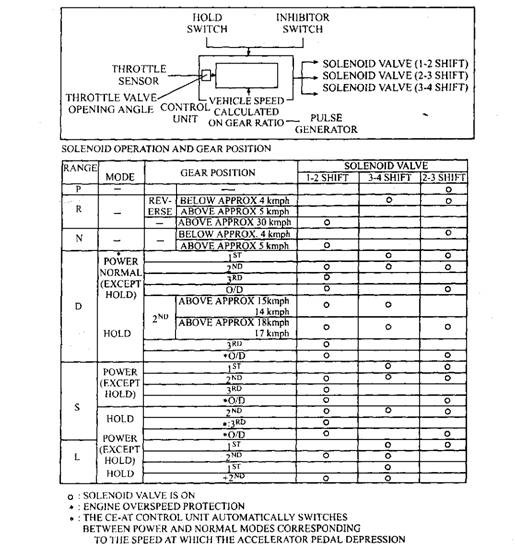
Fig. 25.67. Solenoid operation and gear selection (Mazda).
The engagement force, applied to the brake-band and multi-plate clutches, is controlled by the pressure solenoid. This is a 30 Hz duty cycle control valve, which modifies the line pressure depending on the signals receives from the ECU. Line pressure is increased in proportion to throttle opening angle, causing increased clamping force on the friction members to cope with greater engine torque. During gearshifts the line pressure is momentarily reduced to minimize shift shock.
25.27.5.
Total Engine and Transmission Control
One of the key features of most modern automatic transmission is shift comfort, especially those with four or five gears where shift frequency is likely to be greater than in three speed arrangements. To reduce shift shock the transmission and engine ECUs exchange digital data so that the engine output torque during gear-shifting is temporarily lowered. This feature of the control system is known as total controlor engine intervention. Total control reduces torque fluctuations at the transmission output shaft and offers several additional advantages as follows.
(i) A lower line pressure can be used to clamp the friction elements, so that engagement shock is reduced.
(H) Reduced slippage of the friction elements during engagement causes less lining wear. As a result less heating of the transmission fluid takes place, thereby extending its life and increasing the transmission efficiency.
(Hi) Less slippage of the friction elements occurs.
To achieve engine intervention, either fuel injection is cut off or the ignition timing is retarded (or a combination of both). In the Mazda GF4A-EL transaxle, fuel injection is cut off during up shifting and the ignition timing is retarded during downshift (Fig. 25.68).
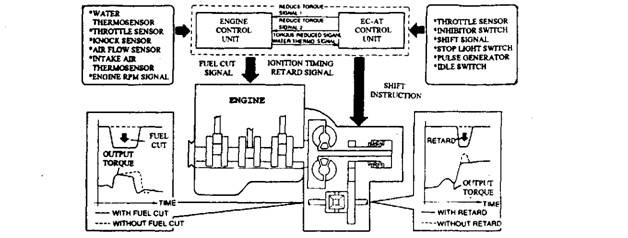
Fig. 25.68. Engine torque reduction during gear-changing (Mazda).
Fuel Injection Cut Off Control.
When the transmission ECU decides for an up-shift (1-2 or 2-3 shift), it sends a “Reduce Torque Signal 1″ (logic 1) to the engine ECU. If a fuel cut takes place considering the engine conditions, the engine ECU confirms its action by sending a “Torque Reduced Signal” back to the transmission ECU. The transmission ECU then performs the gearshift and removes the Reduce Torque Signal 1 to reinstate fuel injection.
Ignition Timing Retardation Control.
When the transmission ECU judges the requirement of a downshift (3-2 or 2-1 shift), it sends a “Reduce Torque Signal 2″ (logic 2) to the engine ECU. The engine ECU then reduces the spark timing by several degrees to lower the engine torque and sends a “Torque Reduced Signal” to transmission ECU as confirmation. Once the down-shift is completed by the transmission ECU, the Reduce Torque Signal 2 is removed and the ignition timing is restored to normal.
25.27.6.
Feedback Control
Another method of providing smoother gear changes is through feedback control of the friction element engagement force. This can be achieved either by directly monitoring various fluid pressures using sensors in the transmission, which is incorporated on some Chrysler
transmissions or by monitoring the instantaneous slippage in the transmission (Fig. 25.69) using speed sensor signals.
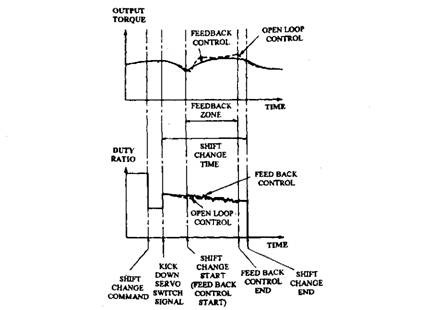
Fig. 25.69. Feedback control of clutch engagement pressure (Mitsubishi).
The latter technique depends on accurate control of the line pressure during gear engagement. This ensures variations in the input shaft speed, and hence the variations in band/clutch slip within a specified range. As a result smooth and consistent shift quality, irrespective of friction material condition and fluid temperature, is achieved.
The speed of the gearbox input shaft, during gear changes, is measured and compared against that of the output shaft. The transmission ECU then calculates the speed gradient of the input shaft {i.e. its declaration). Whenever this calculated valve becomes more or less than a preprogrammed value the drive duty to the line pressure solenoid is lowered or raised accordingly to restore it for ensuring a smooth and steady engagement.
